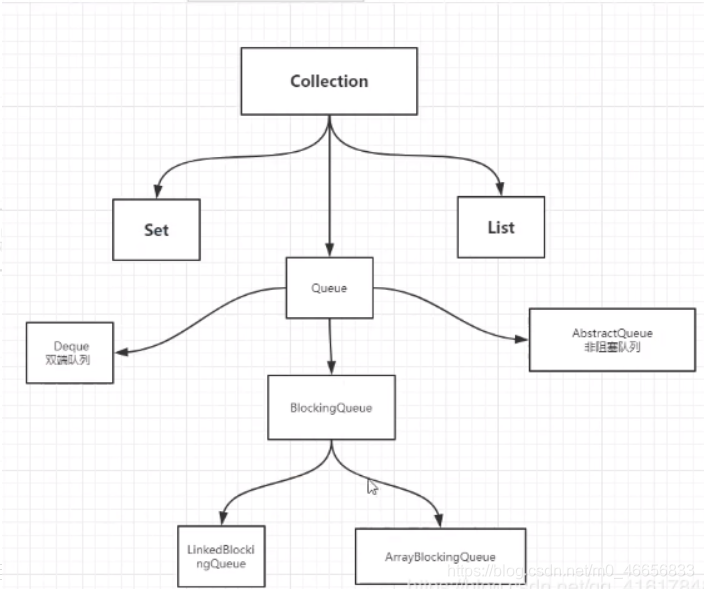复习一下线程池,线程池技术是为了合理管理线程资源而提出的一种技术,这篇文章写的感觉不错,摘出来了线程池技术中的内容,又加上java并发中的内容谈谈我的理解
在一个应用程序中,我们需要多次使用线程,也就意味着,我们需要多次创建并销毁线程。而创建并销毁线程的过程势必会消耗内存。而在Java中,内存资源是及其宝贵的,所以,我们就提出了线程池的概念。
线程池:Java中开辟出了一种管理线程的概念,这个概念叫做线程池,从概念以及应用场景中,我们可以看出,线程池的好处,就是可以方便的管理线程,也可以减少内存的消耗。
那么,我们应该如何创建一个线程池那?Java中已经提供了创建线程池的一个类:Executor
而我们创建时,一般使用它的子类:ThreadPoolExecutor.
public ThreadPoolExecutor(int corePoolSize,
int maximumPoolSize,
long keepAliveTime,
TimeUnit unit,
BlockingQueue workQueue,
ThreadFactory threadFactory,
RejectedExecutionHandler handler)
这是其中最重要的一个构造方法,这个方法决定了创建出来的线程池的各种属性,下面依靠一张图来更好的理解线程池和这几个参数:

又图中,我们可以看出,线程池中的corePoolSize就是线程池中的核心线程数量,这几个核心线程,只是在没有用的时候,也不会被回收,maximumPoolSize就是线程池中可以容纳的最大线程的数量,而keepAliveTime,就是线程池中除了核心线程之外的其他的最长可以保留的时间,因为在线程池中,除了核心线程即使在无任务的情况下也不能被清除,其余的都是有存活时间的,意思就是非核心线程可以保留的最长的空闲时间,而util,就是计算这个时间的一个单位,workQueue,就是等待队列,任务可以储存在任务队列中等待被执行,执行的是FIFIO原则(先进先出)。threadFactory,就是创建线程的线程工厂,最后一个handler,是一种拒绝策略,我们可以在任务满了知乎,拒绝执行某些任务。
线程池的执行流程又是怎样的呢?

有图我们可以看出,任务进来时,首先执行判断,判断核心线程是否处于空闲状态,如果不是,核心线程就先就执行任务,如果核心线程已满,则判断任务队列是否有地方存放该任务,若果有,就将任务保存在任务队列中,等待执行,如果满了,在判断最大可容纳的线程数,如果没有超出这个数量,就开创非核心线程执行任务,如果超出了,就调用handler实现拒绝策略。
handler的拒绝策略:
有四种:第一种AbortPolicy:不执行新任务,直接抛出异常,提示线程池已满
第二种DisCardPolicy:不执行新任务,也不抛出异常
第三种DisCardOldSetPolicy:将消息队列中的第一个任务替换为当前新进来的任务执行
第四种CallerRunsPolicy:直接调用execute来执行当前任务
五,四种常见的线程池:
CachedThreadPool:可缓存的线程池,该线程池中没有核心线程,非核心线程的数量为Integer.max_value,就是无限大,当有需要时创建线程来执行任务,没有需要时回收线程,适用于耗时少,任务量大的情况。
SecudleThreadPool:周期性执行任务的线程池,按照某种特定的计划执行线程中的任务,有核心线程,但也有非核心线程,非核心线程的大小也为无限大。适用于执行周期性的任务。
SingleThreadPool:只有一条线程来执行任务,适用于有顺序的任务的应用场景。
FixedThreadPool:定长的线程池,有核心线程,核心线程的即为最大的线程数量,没有非核心线程
阻塞队列
1)BlockQueue
是Collection的一个子类
什么情况下我们会使用阻塞队列
多线程并发处理、线程池
BlockingQueue 有四组api

方式 抛出异常 不会抛出异常,有返回值 阻塞,等待 超时等待
添加 add offer put offer(timenum.timeUnit)
移出 remove poll take poll(timenum,timeUnit)
判断队首元素 element peek - -
/**
* 抛出异常
*/
public static void test1(){
//需要初始化队列的大小
ArrayBlockingQueue blockingQueue = new ArrayBlockingQueue<>(3);
System.out.println(blockingQueue.add("a"));
System.out.println(blockingQueue.add("b"));
System.out.println(blockingQueue.add("c"));
//抛出异常:java.lang.IllegalStateException: Queue full
// System.out.println(blockingQueue.add("d"));
System.out.println(blockingQueue.remove());
System.out.println(blockingQueue.remove());
System.out.println(blockingQueue.remove());
//如果多移除一个
//这也会造成 java.util.NoSuchElementException 抛出异常
System.out.println(blockingQueue.remove());
}
=======================================================================================
/**
* 不抛出异常,有返回值
*/
public static void test2(){
ArrayBlockingQueue blockingQueue = new ArrayBlockingQueue<>(3);
System.out.println(blockingQueue.offer("a"));
System.out.println(blockingQueue.offer("b"));
System.out.println(blockingQueue.offer("c"));
//添加 一个不能添加的元素 使用offer只会返回false 不会抛出异常
System.out.println(blockingQueue.offer("d"));
System.out.println(blockingQueue.poll());
System.out.println(blockingQueue.poll());
System.out.println(blockingQueue.poll());
//弹出 如果没有元素 只会返回null 不会抛出异常
System.out.println(blockingQueue.poll());
}
=======================================================================================
/**
* 等待 一直阻塞
*/
public static void test3() throws InterruptedException {
ArrayBlockingQueue blockingQueue = new ArrayBlockingQueue<>(3);
//一直阻塞 不会返回
blockingQueue.put("a");
blockingQueue.put("b");
blockingQueue.put("c");
//如果队列已经满了, 再进去一个元素 这种情况会一直等待这个队列 什么时候有了位置再进去,程序不会停止
// blockingQueue.put("d");
System.out.println(blockingQueue.take());
System.out.println(blockingQueue.take());
System.out.println(blockingQueue.take());
//如果我们再来一个 这种情况也会等待,程序会一直运行 阻塞
System.out.println(blockingQueue.take());
}
=======================================================================================
/**
* 等待 超时阻塞
* 这种情况也会等待队列有位置 或者有产品 但是会超时结束
*/
public static void test4() throws InterruptedException {
ArrayBlockingQueue blockingQueue = new ArrayBlockingQueue<>(3);
blockingQueue.offer("a");
blockingQueue.offer("b");
blockingQueue.offer("c");
System.out.println("开始等待");
blockingQueue.offer("d",2, TimeUnit.SECONDS); //超时时间2s 等待如果超过2s就结束等待
System.out.println("结束等待");
System.out.println("===========取值==================");
System.out.println(blockingQueue.poll());
System.out.println(blockingQueue.poll());
System.out.println(blockingQueue.poll());
System.out.println("开始等待");
blockingQueue.poll(2,TimeUnit.SECONDS); //超过两秒 我们就不要等待了
System.out.println("结束等待");
}
1
2
3
4
5
6
7
8
9
10
11
12
13
14
15
16
17
18
19
20
21
22
23
24
25
26
27
28
29
30
31
32
33
34
35
36
37
38
39
40
41
42
43
44
45
46
47
48
49
50
51
52
53
54
55
56
57
58
59
60
61
62
63
64
65
66
67
68
69
70
71
72
73
74
75
76
77
78
79
80
2)同步队列
同步队列 没有容量,也可以视为容量为1的队列;
进去一个元素,必须等待取出来之后,才能再往里面放入一个元素;
put方法 和 take方法;
Synchronized 和 其他的BlockingQueue 不一样 它不存储元素;
put了一个元素,就必须从里面先take出来,否则不能再put进去值!
并且SynchronousQueue 的take是使用了lock锁保证线程安全的。
package com.marchsoft.queue;
import java.util.concurrent.BlockingDeque;
import java.util.concurrent.BlockingQueue;
/**
* Description:
*
* @author jiaoqianjin
* Date: 2020/8/12 10:02
**/
public class SynchronousQueue {
public static void main(String[] args) {
BlockingQueue<String> synchronousQueue = new java.util.concurrent.SynchronousQueue<>();
// 网queue中添加元素
new Thread(() -> {
try {
System.out.println(Thread.currentThread().getName() + "put 01");
synchronousQueue.put("1");
System.out.println(Thread.currentThread().getName() + "put 02");
synchronousQueue.put("2");
System.out.println(Thread.currentThread().getName() + "put 03");
synchronousQueue.put("3");
} catch (InterruptedException e) {
e.printStackTrace();
}
}).start();
// 取出元素
new Thread(()-> {
try {
System.out.println(Thread.currentThread().getName() + "take" + synchronousQueue.take());
System.out.println(Thread.currentThread().getName() + "take" + synchronousQueue.take());
System.out.println(Thread.currentThread().getName() + "take" + synchronousQueue.take());
}catch (InterruptedException e) {
e.printStackTrace();
}
}).start();
}
}
1
2
3
4
5
6
7
8
9
10
11
12
13
14
15
16
17
18
19
20
21
22
23
24
25
26
27
28
29
30
31
32
33
34
35
36
37
38
39
40
41
Thread-0put 01
Thread-1take1
Thread-0put 02
Thread-1take2
Thread-0put 03
Thread-1take3
以下是java并发中的知识
第10章 Executor框架
在Java中,使用线程来异步执行任务。Java线程的创建与销毁需要一定的开销,如果我们 为每一个任务创建一个新线程来执行,这些线程的创建与销毁将消耗大量的计算资源。同时, 为每一个任务创建一个新线程来执行,这种策略可能会使处于高负荷状态的应用最终崩溃。 Java的线程既是工作单元,也是执行机制。从JDK 5开始,把工作单元与执行机制分离开 来。工作单元包括Runnable和Callable,而执行机制由Executor框架提供。
10.1 Executor框架简介 10.1.1 Executor框架的两级调度模型 在HotSpot VM的线程模型中,Java线程(java.lang.Thread)被一对一映射为本地操作系统线 程。Java线程启动时会创建一个本地操作系统线程;当该Java线程终止时,这个操作系统线程 也会被回收。操作系统会调度所有线程并将它们分配给可用的CPU。 在上层,Java多线程程序通常把应用分解为若干个任务,然后使用用户级的调度器 (Executor框架)将这些任务映射为固定数量的线程;在底层,操作系统内核将这些线程映射到 硬件处理器上。这种两级调度模型的示意图如图10-1所示。 从图中可以看出,应用程序通过Executor框架控制上层的调度;而下层的调度由操作系统 内核控制,下层的调度不受应用程序的控制。
10.1.2 Executor框架的结构与成员 本文将分两部分来介绍Executor:Executor的结构和Executor框架包含的成员组件。

图10-1 任务的两级调度模型 1.Executor框架的结构 Executor框架主要由3大部分组成如下。
·任务。包括被执行任务需要实现的接口:Runnable接口或Callable接口。 ·任务的执行。包括任务执行机制的核心接口Executor,以及继承自Executor的 ExecutorService接口。Executor框架有两个关键类实现了ExecutorService接口 (ThreadPoolExecutor和ScheduledThreadPoolExecutor)。 ·异步计算的结果。包括接口Future和实现Future接口的FutureTask类。 Executor框架包含的主要的类与接口如图10-2所示。 下面是这些类和接口的简介。 ·Executor是一个接口,它是Executor框架的基础,它将任务的提交与任务的执行分离开 来。 ·ThreadPoolExecutor是线程池的核心实现类,用来执行被提交的任务。 ·ScheduledThreadPoolExecutor是一个实现类,可以在给定的延迟后运行命令,或者定期执 行命令。ScheduledThreadPoolExecutor比Timer更灵活,功能更强大。 ·Future接口和实现Future接口的FutureTask类,代表异步计算的结果。 ·Runnable接口和Callable接口的实现类,都可以被ThreadPoolExecutor或Scheduled- ThreadPoolExecutor执行。 Executor框架的使用示意图如图10-3所示。

图10-3 Executor框架的使用示意图 主线程首先要创建实现Runnable或者Callable接口的任务对象。工具类Executors可以把一 个Runnable对象封装为一个Callable对象(Executors.callable(Runnable task)或 Executors.callable(Runnable task,Object resule))。 然后可以把Runnable对象直接交给ExecutorService执行(ExecutorService.execute(Runnable command));或者也可以把Runnable对象或Callable对象提交给ExecutorService执行(Executor- Service.submit(Runnable task)或ExecutorService.submit(Callabletask))。 如果执行ExecutorService.submit(…),ExecutorService将返回一个实现Future接口的对象 (到目前为止的JDK中,返回的是FutureTask对象)。由于FutureTask实现了Runnable,程序员也可 以创建FutureTask,然后直接交给ExecutorService执行。 最后,主线程可以执行FutureTask.get()方法来等待任务执行完成。主线程也可以执行
FutureTask.cancel(boolean mayInterruptIfRunning)来取消此任务的执行。 2.Executor框架的成员 本节将介绍Executor框架的主要成员:ThreadPoolExecutor、ScheduledThreadPoolExecutor、 Future接口、Runnable接口、Callable接口和Executors。 (1)ThreadPoolExecutor ThreadPoolExecutor通常使用工厂类Executors来创建。Executors可以创建3种类型的 ThreadPoolExecutor:SingleThreadExecutor、FixedThreadPool和CachedThreadPool。 下面分别介绍这3种ThreadPoolExecutor。 1)FixedThreadPool。下面是Executors提供的,创建使用固定线程数的FixedThreadPool的 API。public static ExecutorService newFixedThreadPool(int nThreads) public static ExecutorService newFixedThreadPool(int nThreads, ThreadFactorythreadFactory) FixedThreadPool适用于为了满足资源管理的需求,而需要限制当前线程数量的应用场 景,它适用于负载比较重的服务器。 2)SingleThreadExecutor。下面是Executors提供的,创建使用单个线程的SingleThread- Executor的API。 public static ExecutorService newSingleThreadExecutor() public static ExecutorService newSingleThreadExecutor(ThreadFactory threadFactory) SingleThreadExecutor适用于需要保证顺序地执行各个任务;并且在任意时间点,不会有多 个线程是活动的应用场景。
3)CachedThreadPool。下面是Executors提供的,创建一个会根据需要创建新线程的 CachedThreadPool的API。 public static ExecutorService newCachedThreadPool() public static ExecutorService newCachedThreadPool(ThreadFactory threadFactory) CachedThreadPool是大小无界的线程池,适用于执行很多的短期异步任务的小程序,或者 是负载较轻的服务器。 (2)ScheduledThreadPoolExecutor ScheduledThreadPoolExecutor通常使用工厂类Executors来创建。Executors可以创建2种类 型的ScheduledThreadPoolExecutor,如下。 ·ScheduledThreadPoolExecutor。包含若干个线程的ScheduledThreadPoolExecutor。 ·SingleThreadScheduledExecutor。只包含一个线程的ScheduledThreadPoolExecutor。 下面分别介绍这两种ScheduledThreadPoolExecutor。 下面是工厂类Executors提供的,创建固定个数线程的ScheduledThreadPoolExecutor的API。 public static ScheduledExecutorService newScheduledThreadPool(int corePoolSize) public static ScheduledExecutorService newScheduledThreadPool(int corePoolSize,ThreadFactory threadFactory) ScheduledThreadPoolExecutor适用于需要多个后台线程执行周期任务,同时为了满足资源 管理的需求而需要限制后台线程的数量的应用场景。下面是Executors提供的,创建单个线程 的SingleThreadScheduledExecutor的API。 public static ScheduledExecutorService newSingleThreadScheduledExecutor() public static ScheduledExecutorService newSingleThreadScheduledExecutor (ThreadFactory threadFactory)
SingleThreadScheduledExecutor适用于需要单个后台线程执行周期任务,同时需要保证顺 序地执行各个任务的应用场景。 (3)Future接口 Future接口和实现Future接口的FutureTask类用来表示异步计算的结果。当我们把Runnable 接口或Callable接口的实现类提交(submit)给ThreadPoolExecutor或 ScheduledThreadPoolExecutor时,ThreadPoolExecutor或ScheduledThreadPoolExecutor会向我们 返回一个FutureTask对象。下面是对应的API。 Future submit(Callable task) Future submit(Runnable task, T result) Future<> submit(Runnable task) 有一点需要读者注意,到目前最新的JDK 8为止,Java通过上述API返回的是一个 FutureTask对象。但从API可以看到,Java仅仅保证返回的是一个实现了Future接口的对象。在将 来的JDK实现中,返回的可能不一定是FutureTask。 (4)Runnable接口和Callable接口 Runnable接口和Callable接口的实现类,都可以被ThreadPoolExecutor或Scheduled- ThreadPoolExecutor执行。它们之间的区别是Runnable不会返回结果,而Callable可以返回结 果。 除了可以自己创建实现Callable接口的对象外,还可以使用工厂类Executors来把一个 Runnable包装成一个Callable。 下面是Executors提供的,把一个Runnable包装成一个Callable的API。 public static Callable callable(Runnable task) // 假设返回对象Callable1
下面是Executors提供的,把一个Runnable和一个待返回的结果包装成一个Callable的API。 public static Callable callable(Runnable task, T result) // 假设返回对象Callable2 前面讲过,当我们把一个Callable对象(比如上面的Callable1或Callable2)提交给 ThreadPoolExecutor或ScheduledThreadPoolExecutor执行时,submit(…)会向我们返回一个 FutureTask对象。我们可以执行FutureTask.get()方法来等待任务执行完成。当任务成功完成后 FutureTask.get()将返回该任务的结果。例如,如果提交的是对象Callable1,FutureTask.get()方法 将返回null;如果提交的是对象Callable2,FutureTask.get()方法将返回result对象。
10.2 ThreadPoolExecutor详解 Executor框架最核心的类是ThreadPoolExecutor,它是线程池的实现类,主要由下列4个组 件构成。 ·corePool:核心线程池的大小。 ·maximumPool:最大线程池的大小。 ·BlockingQueue:用来暂时保存任务的工作队列。 ·RejectedExecutionHandler:当ThreadPoolExecutor已经关闭或ThreadPoolExecutor已经饱和 时(达到了最大线程池大小且工作队列已满),execute()方法将要调用的Handler。 ·通过Executor框架的工具类Executors,可以创建3种类型的ThreadPoolExecutor。 ·FixedThreadPool。 ·SingleThreadExecutor。 ·CachedThreadPool。 下面将分别介绍这3种ThreadPoolExecutor。
10.2.1 FixedThreadPool详解 FixedThreadPool被称为可重用固定线程数的线程池。下面是FixedThreadPool的源代码实 现。public static ExecutorService newFixedThreadPool(int nThreads) { return new ThreadPoolExecutor(nThreads, nThreads, 0L, TimeUnit.MILLISECONDS, new LinkedBlockingQueue()); }FixedThreadPool的corePoolSize和maximumPoolSize都被设置为创建FixedThreadPool时指 定的参数nThreads。 当线程池中的线程数大于corePoolSize时,keepAliveTime为多余的空闲线程等待新任务的 最长时间,超过这个时间后多余的线程将被终止。这里把keepAliveTime设置为0L,意味着多余 的空闲线程会被立即终止。 FixedThreadPool的execute()方法的运行示意图如图10-4所示。
图10-4 FixedThreadPool的execute()的运行示意图

对图10-4的说明如下。 1)如果当前运行的线程数少于corePoolSize,则创建新线程来执行任务。 2)在线程池完成预热之后(当前运行的线程数等于corePoolSize),将任务加入 LinkedBlockingQueue。 3)线程执行完1中的任务后,会在循环中反复从LinkedBlockingQueue获取任务来执行。 FixedThreadPool使用无界队列LinkedBlockingQueue作为线程池的工作队列(队列的容量为 Integer.MAX_VALUE)。使用无界队列作为工作队列会对线程池带来如下影响。
1)当线程池中的线程数达到corePoolSize后,新任务将在无界队列中等待,因此线程池中 的线程数不会超过corePoolSize。 2)由于1,使用无界队列时maximumPoolSize将是一个无效参数。 3)由于1和2,使用无界队列时keepAliveTime将是一个无效参数。 4)由于使用无界队列,运行中的FixedThreadPool(未执行方法shutdown()或 shutdownNow())不会拒绝任务(不会调用RejectedExecutionHandler.rejectedExecution方法)。
10.2.2 SingleThreadExecutor详解 SingleThreadExecutor是使用单个worker线程的Executor。下面是SingleThreadExecutor的源 代码实现。 public static ExecutorService newSingleThreadExecutor() { return new FinalizableDelegatedExecutorService (new ThreadPoolExecutor(1, 1, 0L, TimeUnit.MILLISECONDS, new LinkedBlockingQueue())); }SingleThreadExecutor的corePoolSize和maximumPoolSize被设置为1。其他参数与 FixedThreadPool相同。SingleThreadExecutor使用无界队列LinkedBlockingQueue作为线程池的工 作队列(队列的容量为Integer.MAX_VALUE)。SingleThreadExecutor使用无界队列作为工作队列 对线程池带来的影响与FixedThreadPool相同,这里就不赘述了。 SingleThreadExecutor的运行示意图如图10-5所示。

图10-5 SingleThreadExecutor的execute()的运行示意图 对图10-5的说明如下。 1)如果当前运行的线程数少于corePoolSize(即线程池中无运行的线程),则创建一个新线 程来执行任务。 2)在线程池完成预热之后(当前线程池中有一个运行的线程),将任务加入Linked- BlockingQueue。 3)线程执行完1中的任务后,会在一个无限循环中反复从LinkedBlockingQueue获取任务来 执行。
10.2.3 CachedThreadPool详解 CachedThreadPool是一个会根据需要创建新线程的线程池。下面是创建CachedThread- Pool的源代码。 public static ExecutorService newCachedThreadPool() { return new ThreadPoolExecutor(0, Integer.MAX_VALUE, 60L, TimeUnit.SECONDS, new SynchronousQueue()); }CachedThreadPool的corePoolSize被设置为0,即corePool为空;maximumPoolSize被设置为 Integer.MAX_VALUE,即maximumPool是无界的。这里把keepAliveTime设置为60L,意味着 CachedThreadPool中的空闲线程等待新任务的最长时间为60秒,空闲线程超过60秒后将会被 终止。FixedThreadPool和SingleThreadExecutor使用无界队列LinkedBlockingQueue作为线程池的 工作队列。CachedThreadPool使用没有容量的SynchronousQueue作为线程池的工作队列,但 CachedThreadPool的maximumPool是无界的。这意味着,如果主线程提交任务的速度高于 maximumPool中线程处理任务的速度时,CachedThreadPool会不断创建新线程。极端情况下, CachedThreadPool会因为创建过多线程而耗尽CPU和内存资源。 CachedThreadPool的execute()方法的执行示意图如图10-6所示。

图10-6 CachedThreadPool的execute()的运行示意图 对图10-6的说明如下。 1)首先执行SynchronousQueue.offer(Runnable task)。如果当前maximumPool中有空闲线程 正在执行SynchronousQueue.poll(keepAliveTime,TimeUnit.NANOSECONDS),那么主线程执行 offer操作与空闲线程执行的poll操作配对成功,主线程把任务交给空闲线程执行,execute()方 法执行完成;否则执行下面的步骤2)。 2)当初始maximumPool为空,或者maximumPool中当前没有空闲线程时,将没有线程执行 SynchronousQueue.poll(keepAliveTime,TimeUnit.NANOSECONDS)。这种情况下,步骤1)将失 败。此时CachedThreadPool会创建一个新线程执行任务,execute()方法执行完成。 3)在步骤2)中新创建的线程将任务执行完后,会执行 SynchronousQueue.poll(keepAliveTime,TimeUnit.NANOSECONDS)。这个poll操作会让空闲线
程最多在SynchronousQueue中等待60秒钟。如果60秒钟内主线程提交了一个新任务(主线程执 行步骤1)),那么这个空闲线程将执行主线程提交的新任务;否则,这个空闲线程将终止。由于 空闲60秒的空闲线程会被终止,因此长时间保持空闲的CachedThreadPool不会使用任何资源。 前面提到过,SynchronousQueue是一个没有容量的阻塞队列。每个插入操作必须等待另一 个线程的对应移除操作,反之亦然。CachedThreadPool使用SynchronousQueue,把主线程提交的 任务传递给空闲线程执行。CachedThreadPool中任务传递的示意图如图10-7所示。

图10-7 CachedThreadPool的任务传递示意图
10.3 ScheduledThreadPoolExecutor详解 ScheduledThreadPoolExecutor继承自ThreadPoolExecutor。它主要用来在给定的延迟之后运 行任务,或者定期执行任务。ScheduledThreadPoolExecutor的功能与Timer类似,但 ScheduledThreadPoolExecutor功能更强大、更灵活。Timer对应的是单个后台线程,而 ScheduledThreadPoolExecutor可以在构造函数中指定多个对应的后台线程数。






















 1429
1429

 被折叠的 条评论
为什么被折叠?
被折叠的 条评论
为什么被折叠?








